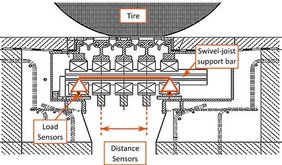
Expansion joint and bearings determine traffic load and monitor bridges

Munich. Real-time monitoring of bridges without on-site inspection is becoming more and more feasible. Within the framework of the ‘Digitales Testfeld Autobahn - DTA’ (Digital Test Field Highway), MAURER SE develops and operates measuring systems in two spherical bearings and one expansion joint – the small word ‘in’ being the decisive word: Various sensors are integrated into components that have to be installed in almost any larger bridge.
The sensor-equipped components are, among others, a part of the current pilot project ‘Intelligente Brücke im Digitalen Testfeld Autobahn’ (Intelligent Bridge in the Digital Test Field Highway) of the German Federal Ministry of Transport and Digital Infrastructure (BMVI), which is coordinated by the Federal Highway Research Institute (BASt). The MMS Spherical Bearings and the MMS Expansion Joint (MMS for Maurer Monitoring System) have been developed over the years and were installed within a newly built replacement bridge at the highway junction Nuremberg (structure BW402e) in 2016. “The expansion joint and the two bearings at axis 40 have successfully passed their first field test”, reports MAURER project manager Dr.-Ing. Christiane Butz. “Data flows continuously, which is evaluated automatically.”
In the text below, the expansion joint and the bearings will be discussed separately, although they are researched together in the project.
Swivel Joist Expansion Joint Classifies Vehicles
Although not completed yet, the expansion joint project has already achieved its key goal: the MMS Expansion Joint is capable of classifying vehicles in real time. Expansion joints are very well suited for measuring traffic loads since they have direct contact with the vehicles and are present in almost any larger bridge. The new feature: All relevant data (speed, load, and time) is obtained at the same location.
For vehicle classification, the peaks are singled out from the total load signal of every lane, as they mark the contact with the tires. After the relevant data for each axle has been evaluated, the values of the individual axles are grouped and the vehicle type is determined based on axle configuration and axle load. This corresponds to the function of a Weigh-In-Motion device with presently an accuracy about 10% of the axle loads.
Contacto oficina central
MAURER SE
Frankfurter Ring 193
80807 Munich
Alemania
Phone +49. 89. 32394-0
Mail







